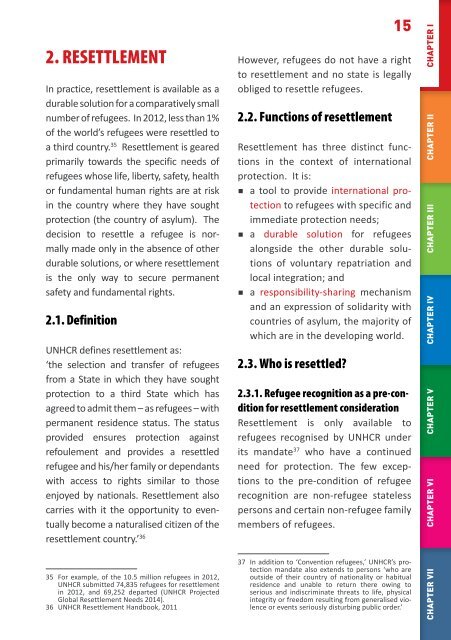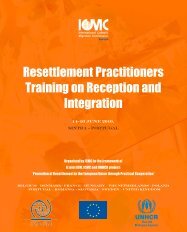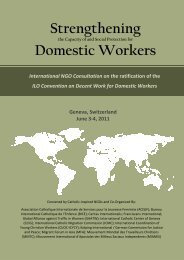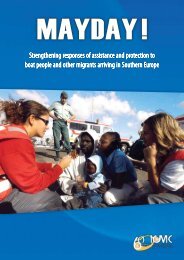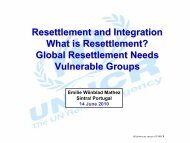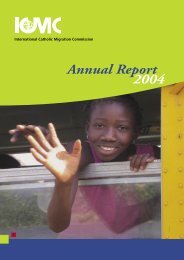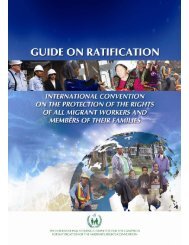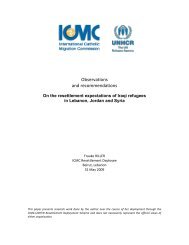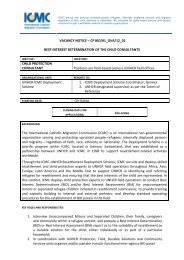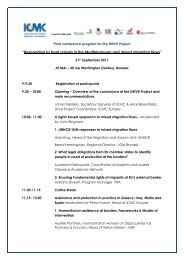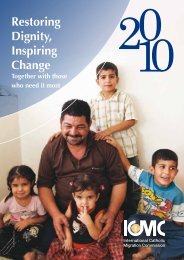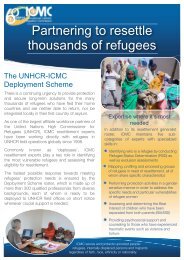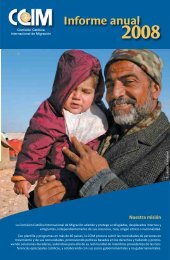ICMCEUROPE WelcometoEurope.pdf (5.89 MB)
ICMCEUROPE WelcometoEurope.pdf (5.89 MB)
ICMCEUROPE WelcometoEurope.pdf (5.89 MB)
You also want an ePaper? Increase the reach of your titles
YUMPU automatically turns print PDFs into web optimized ePapers that Google loves.
2. RESETTLEMENT<br />
In practice, resettlement is available as a<br />
durable solution for a comparatively small<br />
number of refugees. In 2012, less than 1%<br />
of the world’s refugees were resettled to<br />
a third country. 35 Resettlement is geared<br />
primarily towards the specific needs of<br />
refugees whose life, liberty, safety, health<br />
or fundamental human rights are at risk<br />
in the country where they have sought<br />
protection (the country of asylum). The<br />
decision to resettle a refugee is normally<br />
made only in the absence of other<br />
durable solutions, or where resettlement<br />
is the only way to secure permanent<br />
safety and fundamental rights.<br />
2.1. Definition<br />
UNHCR defines resettlement as:<br />
‘the selection and transfer of refugees<br />
from a State in which they have sought<br />
protection to a third State which has<br />
agreed to admit them – as refugees – with<br />
permanent residence status. The status<br />
provided ensures protection against<br />
refoulement and provides a resettled<br />
refugee and his/her family or dependants<br />
with access to rights similar to those<br />
enjoyed by nationals. Resettlement also<br />
carries with it the opportunity to eventually<br />
become a naturalised citizen of the<br />
resettlement country.’ 36<br />
35 For example, of the 10.5 million refugees in 2012,<br />
UNHCR submitted 74,835 refugees for resettlement<br />
in 2012, and 69,252 departed (UNHCR Projected<br />
Global Resettlement Needs 2014).<br />
36 UNHCR Resettlement Handbook, 2011<br />
However, refugees do not have a right<br />
to resettlement and no state is legally<br />
obliged to resettle refugees.<br />
2.2. Functions of resettlement<br />
Resettlement has three distinct functions<br />
in the context of international<br />
protection. It is:<br />
• a tool to provide international protection<br />
to refugees with specific and<br />
immediate protection needs;<br />
• a durable solution for refugees<br />
alongside the other durable solutions<br />
of voluntary repatriation and<br />
local integration; and<br />
• a responsibility-sharing mechanism<br />
and an expression of solidarity with<br />
countries of asylum, the majority of<br />
which are in the developing world.<br />
2.3. Who is resettled?<br />
15<br />
2.3.1. Refugee recognition as a pre-condition<br />
for resettlement consideration<br />
Resettlement is only available to<br />
refugees recognised by UNHCR under<br />
its mandate 37 who have a continued<br />
need for protection. The few exceptions<br />
to the pre-condition of refugee<br />
recognition are non-refugee stateless<br />
persons and certain non-refugee family<br />
members of refugees.<br />
37 In addition to ‘Convention refugees,’ UNHCR’s protection<br />
mandate also extends to persons ‘who are<br />
outside of their country of nationality or habitual<br />
residence and unable to return there owing to<br />
serious and indiscriminate threats to life, physical<br />
integrity or freedom resulting from generalised violence<br />
or events seriously disturbing public order.’<br />
CHAPTER II CHAPTER I<br />
CHAPTER VI CHAPTER V<br />
CHAPTER IV<br />
CHAPTER III<br />
CHAPTER VII


